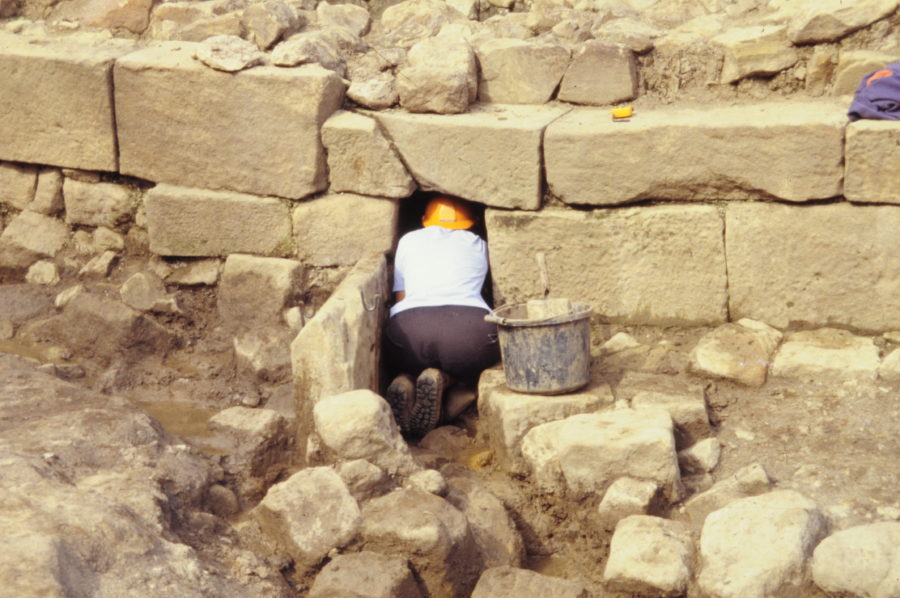An archaeological report on findings from Roman fort at Hadrian’s Wall
Segedunum Roman Fort and Museum—A new archaeological report hailed as the definitive full account of the excavations of Hadrian’s Wall at its eastern end has just been published.
Hadrian’s Wall at Wallsend is written by Paul Bidwell OBE, former Head of Archaeology at Tyne & Wear Archives & Museums (TWAM), and encapsulates the knowledge gleaned from 28 years of intermittent excavations around Segedunum Roman Fort, Wallsend in North Tyneside.
Taking place between 1988 and 2015, these digs culminated in the Treasury-funded project that saw the rediscovery of the fort’s baths as well as the public display of the full stretch of Wall remains.
The Hadrian’s Wall at Wallsend report represents an account of one of the most comprehensively excavated sections of Hadrian’s Wall anywhere along its 73-mile length.
Paul Bidwell, author, and President of The Arbeia Society said: “It has been a privilege to draw together the results of so many years work by so many people.
The results are a great advance in our understanding of how Hadrian’s Wall was built and of its later history.
They also show that the remains of the Wall in urban Tyneside are just as important as the better-preserved lengths in rural Northumberland.”
Paul Bidwell was Head of Archaeology at TWAM until retirement. He has led and published excavations in Exeter and along Hadrian’s Wall, including at South Shields, Vindolanda, Newcastle, Chesters and Willowford; and has been a contributor to many other publications on aspects of Roman Archaeology, including Roman ceramics.
The driving force behind one of the UK’s most ambitious and controversial reconstruction projects at Arbeia, South Shields Roman Fort, 31 years ago Paul Bidwell led the charge to recreate a fort gate house in its original foundations.
The report has been published by TWAM with The Arbeia Society, a registered charity established in 1992 to support research into and promotion of Roman archaeology in North East England.
North Tyneside’s Elected Mayor, Norma Redfearn CBE, said: “We welcome the publication of this report.
It is a significant achievement by Paul and one that will help to enrich our knowledge and understanding of one of our most precious heritage sites.” Iain Watson, Director of TWAM said: “This is a very significant contribution to the body of knowledge of Hadrian’s Wallsend, a huge undertaking, bringing together and translating into contemporary context 28 years of archaeological findings.
We congratulate Paul and look forward to the report’s reception.”Segedunum Roman Fort and Museum is now a visitor attraction incorporating a museum and an extensively excavated Roman ‘archaeological park’ fort site, overlooked by a 35m viewing tower attracting around 50,000 visits a year.
1,900 years ago it was the edge of the Roman Empire, the very cusp of the eastern end of the Empire’s northern frontier. Segedunum – meaning ‘strong place’ – sat on a plateau overlooking the north bank of the River Tyne, the spot was chosen strategically to command views east down the river to the coast at South Shields and 2 miles up the river toward Newcastle upon Tyne.
The 73-mile wall, now a World Heritage Site, was constructed on the orders of Emperor Hadrian in AD122 and originally ended at the River Tyne’s lowest bridgeable point – Newcastle upon Tyne – until 2 or 3 years later when it was extended to Wallsend.
Only 7% of the original wall is visible today and only about 0.5% of its entire length has been excavated using modern archaeological techniques, though much more can be seen of the forts, milecastles, turrets, and bridges along its line.
The 80 meter stretch at Wallsend that has been scrutinized by archaeologists over the years lies 50 meters west of the Segedunum fort. Its first contemporary digs were led by the late Charles Daniels of Newcastle University in the mid-1970s. The Wall at Wallsend, 2.26m wide, was built without mortar but with carefully-laid courses of stonework.
Separate groups of legionaries built lengths of 30 Roman feet (about 9m). They were also tasked with building an aqueduct which ran through the Wall and supplied the baths outside the fort.
Markers for building plots running up to the back of the Wall were also found. They show that a settlement containing civilian and some military buildings were laid out at the same time that the Wall and the adjacent fort were built.
In the early 3rd century, the Wall at Segedunum was destroyed by a catastrophic flood which also washed away part of the baths and undermined the fort wall.
The aqueduct was replaced and the Wall rebuilt, probably on the instructions of Septimius Severus in about AD 208; this emperor, rather than Hadrian, was credited by late-Roman writers as the original builder of the Wall. Shorter lengths of the Wall collapsed and were rebuilt on three subsequent occasions. One of these later reconstructions reused masonry from various buildings, including one of the fort gates, a temple possibly dedicated to Diana, and a bathhouse.
The volume also includes an account of the building of the replica section of Hadrian’s Wall at Segedunum, constructed in 1996.

